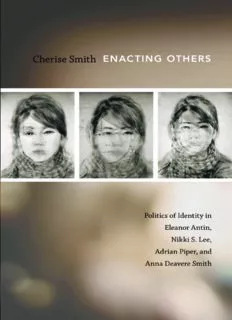
Enacting Others: Politics of Identity in Eleanor Antin, Nikki S. Lee, Adrian Piper, and Anna Deavere Smith PDF
Preview Enacting Others: Politics of Identity in Eleanor Antin, Nikki S. Lee, Adrian Piper, and Anna Deavere Smith
Enacting Others Enacting Others Politics of Identity in Eleanor Antin, Nikki S. Lee, Adrian Piper, and Anna Deavere Smith Cherise Smith Duke university Press Durham & London 2011 © 2011 Duke University Press All rights reserved Printed in the United States of America on acid-free paper ♾ Designed by Jennifer Hill Typeset in Chaparral Pro by Tseng Information Systems, Inc. Library of Congress Cataloging-in-Publication Data appear on the last printed page of this book. Duke University Press greatly appreciates the support of the University of Texas, Austin, in the publication of this book. Duke University Press gratefully acknowledges a University Co-operative Society Subvention Grant awarded by the University of Texas, Austin, which provided funds toward the production of this book. For G and S and W and B Contents ix Preface xiii Acknowledgments 1 Introduction 1 27 “The Politics of My Position” ADriAn PiPer AnD Mythic Being 2 79 The Other “Other” eleAnor Antin AnD the PerformAnce of BlAckness 3 135 “Other-Oriented” Performance AnnA DeAvere smith AnD twilight: los Angeles 4 189 Nikki S. Lee’s Projects and the Repackaging of the Politics of Identity 233 Conclusion 243 Notes 277 Bibliography 293 Index Preface The ideas delineated in this book grew out of insights gained from the course “Cyborgs and Synthetic Humans” taught by Scott Bukatman in the fall of 1999 at Stanford Univer- sity.1 In the course of my duties as a teaching assistant, I came to realize that many science fiction texts are thinly veiled allegories that meditate on racial difference and iden- tity. Human characters are surrogates for whites: they and the fictional societies in which they are embedded are de- picted as normative and sought after. By contrast, non- human characters are substitutes for blacks: they are por- trayed as possessing key differences, such as superhuman strength or subhuman intelligence, which normalize their powerless and debased position in the fictional social peck- ing order. These narratives typically take one of two courses: they advocate for integration and tolerance by encourag- ing viewers (who are always presumed to be white) to see the “humanity” in nonhuman characters, or they promote the maintenance of strict boundaries between humans and nonhumans in order to preserve the established hierarchy. I was eager to apply that framework to Ridley Scott’s Blade Runner (1982 and 1991)—the ever-popular film based on Phillip K. Dick’s novel Do Androids Dream of Electric Sheep? (1968) and to which considerable critical energy has been
Description: